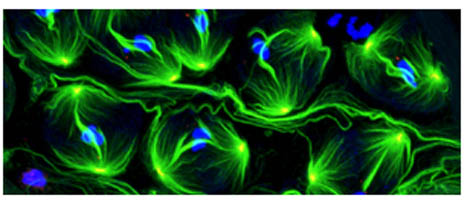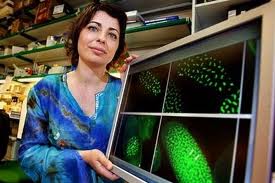 A team of researchers led by Mónica Bettencourt-Dias, from the Gulbenkian Institute of Science, won the 2012 edition of the Pfizer Basic Research Award for their work in understanding sperm tail motility.
A team of researchers led by Mónica Bettencourt-Dias, from the Gulbenkian Institute of Science, won the 2012 edition of the Pfizer Basic Research Award for their work in understanding sperm tail motility.
The team of researchers led by Monica Bettencourt-Dias, from the Gulbenkian Science Institute (IGC) won the 2012 edition of the Pfizer Prize for Basic Research, worth €20, awarded by Lisbon Society of Medical Sciences (SCML) and the Pfizer Laboratories. The handover ceremony took place this Wednesday, November 28, at the Faculty of Medical Sciences of Universidade Nova de Lisboa, with the presence of the Deputy Secretary of State for the Minister of Health, Fernando Leal da Costa, and the Secretary of State of Science Leonor Parreira.
The awarded work was coordinated by Zita Carvalho-Santos and Mónica Bettencourt-Dias, involving several other researchers from this IGC group, and collaborators from ITQB (Institute of Chemical and Biological Technology) and EMBL (European Molecular Biology Laboratory, Germany).
This investigation allowed us to discover how the cell builds the flagellum. Flagella are essential for cell movement (eg sperm) or fluid movement, ensuring that this fluid and what it carries (dust, eggs, etc.) move in a single direction. Alterations in these structures underlie a variety of human diseases, such as pulmonary dysfunction, hydrocephalus and sterility.

Pedro Machado, from the IGC team, used electron microscopy techniques, which make it possible to study structures around 3500 times smaller than the tip of a human hair, to describe the microscopic steps that lead to the formation of the fly's sperm flagellum. fruit, Drosophila melanogaster.
“Scourges are highly complex machines. They are like wheels with an axle that coordinates their movement. We characterize the formation of the structure equivalent to the axle of the wheels. Without this protein structure called “central pair of microtubules”, the flagellum does not move correctly”, says Zita Carvalho-Santos.
This researcher discovered a protein essential to form the “wheel hub”, called BLD10. In its absence, sperm with immobile flagella form, resulting in sterile flies. Humans have a protein similar to this one that has been linked in previous studies to male infertility.
“This is the second time that our work has been recognized with the Pfizer Award. This time it will help us to purchase equipment so we can see very small structures like the scourges live, saving us a lot of time. We need more prizes and private investment in research in Portugal”, says Mónica Bettencourt-Dias.
This is the fifth time that IGC groups have seen their work distinguished with the Pfizer Research Awards. In 2010, the Basic Research Award was awarded to Moisés Mallo's group for its work in the area of development and evolution of the musculoskeletal system. Carlos Penha‐Gonçalves and Rosário Bragança Sambo also received the 2010 Clinical Research Award for their work in the area of cerebral malaria in children.
In 2009, the research groups of Miguel Godinho Ferreira (Telomeres and Genomic Stability group) and Miguel Soares (inflammation group) won ex-aequo the Pfizer Prize for Basic Research.
In 2007, the same prize was awarded to Ana Rodrigues Martins and Mónica Bettencourt-Dias, for their work in shaping the skeleton of cells. In 2004, the Prize was awarded to the IGC Research Team led by Jocelyne Demengeot.
Author: Agnes Domingues
Science Communication and External Relations/ Instituto Gulbenkian de Ciência
Science in the Regional Press – Ciência Viva


















Comments